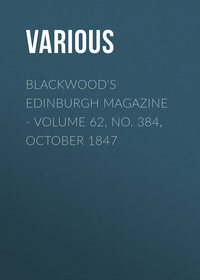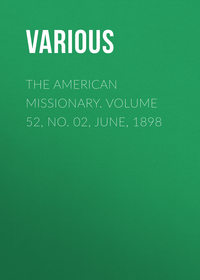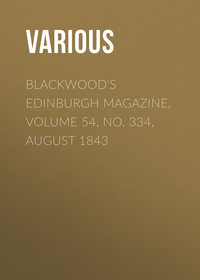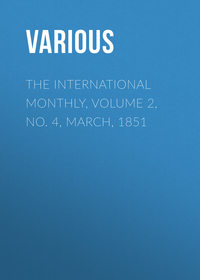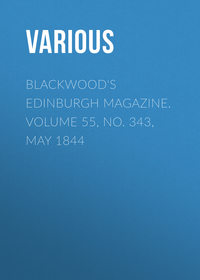![Birds Illustrated by Color Photography [February, 1898]](/covers_330/25570839.jpg) полная версия
полная версияBirds Illustrated by Color Photography [February, 1898]

Various
Birds Illustrated by Color Photography [February, 1898] / A Monthly Serial designed to Promote Knowledge of Bird-Life
GILBERT WHITE AND “SELBORNE.”
I SUPPOSE that a habit of minute observation of nature is one of the most difficult things to acquire, as it is one which is less generally pursued than any other study. In almost all departments of learning and investigation there have been numberless works published to illustrate them, and text books would fill the shelves of a large library. Thoreau in his “Walden” has shown an extremely fine and close observation of the scenes in which his all too short life was passed, but his object does not seem at any time to have been the study of nature from an essential love of it, or to add to his own or the world’s knowledge. On the contrary, nature was the one resource which enabled him to exemplify his notions of independence, which were of such a sturdy and uncompromising character that Mr. Emerson, who had suffered some inconvenience from his experience of Thoreau as an inmate of his household, thought him fitter to meet occasionally in the open air than as a guest at table and fireside. There is a delicious harmony with nature in all that he has written, but his descriptions of out-of-door life invite us rather to indolent musing than to investigation or study. Who after reading Izaak Walton ever went a-fishing with the vigor and enterprise of Piscator? Washington Irving allowed his cork to drift with the current and lay down in the shadow of a spreading oak to dream with the beloved old author.
In White’s “Natural History of Selborne” we have a unique book indeed, but of a far more general interest than its title would indicate. Pliny, the elder, was the father of natural history but to many of us Gilbert White is entitled to that honor. To an early edition of the book, without engravings, and much abridged, as compared with Bohn’s, published in 1851, many owe their first interest in the subject.
Mr. Ireland in his charming little “Book Lover’s Enchiridion,” tells us that when a boy he was so delighted with it, that in order to possess a copy of his own (books were not so cheap as now) he actually copied out the whole work. In a list of one hundred books, Sir John Lubbock mentions it as “an inestimable blessing.” Edward Jesse, author of “Gleanings in Natural History” attributes his own pursuits as an out-door naturalist entirely to White’s example. Much of the charm of the book consists in the amiable character of the author, who
“ – lived in solitude, midst trees and flowers,Life’s sunshine mingling with its passing showers;No storms to startle, and few clouds to shadeThe even path his Christian virtues made.”Very little is known of him beyond what he has chosen to mention in his diaries, which were chiefly records of his daily studies and observations, and in his correspondence, from which the “history” is in fact made up. From these it is evident that his habits were secluded and that he was strongly attached to the charms of rural life. He says the greater part of his time was spent in literary occupations, and especially in the study of nature. He was born July 18, 1720, in the house in which he died. His father was his first instructor in natural history, and to his brother Thomas, a fellow of the Royal Society, he was indebted for many suggestions for his work. It is also to his brother’s influence that we owe the publication of the book, as it required much persuasion to induce the philosopher to pass through the ordeal of criticism, “having a great dread of Reviewers,” those incorrigible bêtes noires of authors. His brother promising himself to review the work in the “Gentleman’s Magazine,” White reluctantly consented to its publication. The following short abstract from the review will show its quality, as well as suggest a possible answer to the current question propounded by students of the census.
“Contemplative persons see with regret the country more and more deserted every day, as they know that every well-regulated family of property which quits a village to reside in a town, injures the place that is forsaken in material circumstances. It is with pleasure, therefore, we observe that so rational an employment of leisure hours as the study of nature promises to become popular, since whatever adds to the number of rural amusements, and consequently counteracts the allurements of the metropolis is, on this consideration, of national importance.”
It is to be feared, however, that many stronger influences than this of the study of nature will be necessary to keep the young men of the present day from the great cities. Indeed, modern naturalists themselves spend the greater part of their lives at the centers of knowledge and only make temporary sallies into the woods and fields to gather data. White was a noble pioneer. The very minuteness – almost painful – of his observation required him to occupy himself for days and weeks and months with what to the average mind would seem of the slightest importance. As an example of his patient investigation, his famous study of the tortoise may be given. It was more than thirty years old when it came into his possession, and for many years – perhaps twenty – we find White watching the habits of the interesting old reptile, until, we may assume, he knew all about him and his species.
There are over three hundred and fifty different species of animals and birds treated by White, most of them exhaustively; the beech tree, the elm, and the oak are described and watched from year to year; and the geology and fossil remains of Selborne district are presented. We have daily accounts of the weather, information of the first tree in leaf, the appearance of the first fungi and the plants first in blossom. He tells us when mosses vegetate, when insects first appear and disappear, when birds are first seen and when they migrate – and a thousand other things; all in a style of such simplicity, united with rare scholarship, that it is well worth the attention and imitation of students of the English language. White was educated at Oxford. He had frequent opportunities, ’tis said, of accepting college livings, but his fondness for his native village made him decline all preferment. To this we owe “Selborne” of which Dr. Beardmore, a distinguished scholar, made the prophetic remark to a nephew of White’s: “Your uncle has sent into the world a publication with nothing to attract attention to it but an advertisement or two in the newspapers; but depend upon it, the time will come when very few who buy books will be without it.”
The village was far less attractive than our imaginations would depict it to have been, and the traveler who would “view fair Selborne aright,” according to a contemporary writer, should humor the caprices of the English climate and visit it only when its fields and foliage are clothed in their summer verdure.
– Charles C. Marble.A FRIEND OF BIRDS
IT is told of George H. Corliss, the famous engine builder of Providence, R. I., that when building a foundry at the Corliss works, some Blue Birds took the opportunity to build in some holes in the interior framework into which horizontal timbers were to go. The birds flew in and out – as Blue Birds will – and went on with their housekeeping, until in the natural course of things the workmen would have evicted them to put the apertures to their intended use of receiving timbers. But Mr. Corliss interfered and showed how the particular aperture the birds were occupying could be left undisturbed until they were done with it, without any serious delay to the building. So the pair came and went in the midst of the noise of building and brought up their little family safely, and after they had flown away, and not until then, that particular part of the framework was completed.
At another time, Mr. Corliss was working on a contract with the city of Providence to supply a steam pumping apparatus, power house and all, at Sockonosset, and the time was short, and there were forfeitures nominated in the bond for every day beyond a a specified date for its completion.
The power house was to be upon virgin soil where were rocks and trees – little trees growing among rocks. In blasting and clearing the necessary place for the foundations of the building, a Robin’s nest was discovered in a little tree within the space where the upheavals were to be made. When Mr. Corliss knew this he had the work transferred to the other side of the square or parallelogram around which the digging and blasting were to go, saying that it was just as well to do the other side first.
But it proved that when the workmen had got clear around and back to the Robin’s tree, the young birds were still not quite ready to fly. This called for a new exercise of an inventor’s power of adapting means to a worthy end. Looking at the little tree with its nest and little birds high in the branches he bade the men support the tree carefully while it was sawed through the trunk a little above the ground, and then carry it in an upright position to a safe distance and stick it into the ground with proper support.
The Robin family continued to thrive after this novel house-moving and all flew away together after a few more days.
QUEER DOINGS OF A CRANE
AWRITER on “Animal Helpers and Servers” gives a remarkable account of a tame Crane, communicated by Von Seyffert. Von Seyffert had a pair of tame Cranes which soon lost all fear of man and of domestic animals, and became strongly attached to the former. Their life in a German village, in which agriculture was the sole employment and the communal system of joint herding of cattle and swine and driving them together to the common pasture prevailed, was very much to their taste. They soon knew all the inhabitants in the place and used to call regularly at the houses to be fed. Then the female died and the survivor at once took as a new friend a bull. He stood by the bull in the stall and kept the flies off him, screamed when he roared, danced before him and followed him out with the herd. In this association the Crane learned the duties of cowherd, so that one evening he brought home the whole of the village herd of heifers unaided and drove them into the stable. From that time the Crane undertook so many duties that he was busy from dawn till night. He acted as policeman among the poultry, stopping all fights and disorder. He stood by a horse when left in a cart and prevented it from moving by pecking its nose and screaming. A Turkey and a Game Cock were found fighting, whereon the Crane first fought the Turkey, then sought out and thrashed the cock. Meantime it herded the cattle, not always with complete success. The bovines were collected in the morning by the sound of a horn and some would lag behind. On one occasion the Crane went back, drove up some lagging heifers through the street and then frightened them so much that they broke away and ran two miles in the wrong direction. The bird could not bring them back, but drove them into a field, where it guarded them until they were fetched. It would drive out trespassing cattle as courageously as a dog and, unlike most busybodies, was a universal favorite and pride of the village. —Cornhill Magazine.
THE LEAST BITTERN
THROUGHOUT the whole of temperate North America and tropical America to Brazil, this, the smallest of the Bittern family, is a well-known bird, but being a nocturnal species, inhabiting the almost inaccessible swamps and boggy lands that are covered with a dense growth of canes, reeds, and rushes, it is seldom met with. Mr. Davis calls it an extremely interesting little bird, of quiet, retiring habits. In some places as many as a dozen or twenty pairs breed along the grassy shores of a small lake or pond. The nest is placed on the ground or in the midst of the rankest grass, or in a bush. It is often placed on floating bog, and is simply a platform of dead rushes.
This bird has many odd habits. When standing on the edge of a stream, with its neck drawn in, it is often taken for a Woodcock, the long bill giving it this appearance. It is so stupid at times that it may be caught with the hand.
The Least Bittern is usually seen just before or after sunset. When startled it utters a low gua, and in daylight flies but a short distance, in a weak, uncertain manner, but at dusk it flaps along on strong easy wing, with neck drawn in and legs extended.
The eggs of this species are usually from two to six in number, and of a pale bluish or greenish-white. If approached while on the nest, the female generally steps quietly to one side, but if suddenly surprised, takes to flight.
The Least Bittern is known by many local names. In Jamaica it is called Tortoise-shell Bird and Minute Bittern, and in many localities Little Bittern.
“All Nature is a unit in herself,Yet but a part of a far greater whole.Little by little you may teach your childTo know her ways and live in harmonyWith her; and then, in turn, help him through herTo find those verities within himself,Of which all outward things are but the type.So when he passes from your sheltering careTo walk the ways of men, his soul shall beKnit to all things that are, and still most free;And of him shall be writ at last this word —‘At peace with nature, with himself, and God.’”THE BALDPATE DUCK
“There seem to be as many Ducks as there are Owls,” remarks Bobbie. “This fellow is called Baldpate, but he’s not bare on top of his head like Gran’pa, at all.”
“No, his head is feathered as well as any Duck’s head,” replies mamma. “I remember hearing him called the Widgeon, I think.”
“Yes, that’s what it says here, the American Widgeon, a game bird, you know, mamma.”
“Yes, its flesh is very delicious, almost as good as the Canvas-back.”
“Oh, but these Baldpates are cunning fellows,” exclaims Bobbie, continuing his reading, “It says they are fond of a certain grass plant which grows deep in both salt and fresh water, but they don’t dive for it as the Canvas-back and other deep water Ducks do.”
“Well?” says mamma, as Bobbie stops, his lips moving, but uttering no sound.
“I stopped to spell a word,” explains Bobbie. “It says they closely follow and watch the Canvas-back and other Ducks, and when they rise to the surface of the water with the roots of the plant in their bills, Mr. Baldpate quickly snatches a part, or all of the catch, and hurries off to eat it at his leisure.”
“A mean fellow, indeed,” remarks mamma, “but he has no reason to guide him, as you have, you know.”
“Indeed I don’t know,” quickly says Bobbie. “You remember that story about the imprisoned Duck that had its leg broken and was put under a small crate, or coop, to keep it from running about? Well, some of the other Ducks pitied the little prisoner and tried to release him by forcing their necks under the crate and thus lifting it up. They found they weren’t strong enough to do that, and so they quacked, and quacked, and quacked among themselves, then marched away in a body. Soon they came back with forty ducks, every one in the farm yard. They surrounded the crate and tried to lift it as before, but again they failed. Then they quacked some more, and after a long talk the whole of them went to one side of the crate. As many as could thrust their necks underneath it, and the rest pushed them forward from behind. A good push, a strong push, up went the crate a little way, and out waddled the little prisoner. I want to know if they didn’t reason that out, mamma?”
THE BALDPATE
We would have you to wit, that on eggs though we sit,And are spiked on a spit, and are baked in a pan,Birds are older by far than your ancestors are,And made love and made war, ere the making of man!– Andrew Lang.THERE is much variation in the plumage of adult males of this species of Widgeon, but as Dr. Coues says: “The bird cannot be mistaken under any condition; the extensive white of the under parts and wings is recognizable at gun-range.” The female is similar, but lacks the white crown and iridescence on the head.
The Baldpate ranges over the whole of North America. In winter it is common in the Gulf states and lower part of the Mississippi Valley. Cooke says it breeds chiefly in the north, but is known to nest in Manitoba, the Dakotas, Minnesota, Nebraska, Kansas, Illinois, and Texas. Throughout the whole of British America, as far north as the Arctic ocean, it is very abundant. In October and April it visits in large numbers the rivers and marshes, as well as both sea coasts of the northern United States, and is much sought by hunters, its flesh being of the finest quality, as when in good condition it cannot easily be distinguished from that of the Canvas-back. It is regarded by hunters as a great nuisance. It is not only so shy that it avoids the points of land, but by its whistling and confused manner of flight is said to alarm the other species. During its stay in the waters of the Chesapeake, it is the constant companion of the Canvas-backs, upon whose superiority in diving it depends in a large degree for its food, stealing from them, as they rise to the surface of the water, the tender roots of the plant of which both are so fond —vallisneria grass, or wild celery. The Baldpate is said to visit the rice fields of the south during the winter in considerable numbers. It winters in the Southern states, Mexico, and the West Indies. In the north, the Widgeon exhibits a greater preference for rivers and open lakes than most of the other fresh-water Ducks.
The favorite situation of the nest is remarkable, for while the other Ducks – except, perhaps, the Teal, according to Mr. Kennicott – choose the immediate vicinity of water, he found the Baldpate always breeding at a considerable distance from it. Several of the nests observed on the Yukon were fully half a mile from the nearest water. He invariably found the nest among dry leaves, upon high, dry ground, either under large trees or in thick groves of small ones – frequently among thick spruces. The nest is small, simply a depression among the leaves, but thickly lined with down, with which after setting is begun, the eggs are covered when left by the parent. They are from eight to twelve in number, and pale buff. The food of the Baldpate consists of aquatic insects, small shells, and the seeds and roots of various plants.
The call of this bird is a plaintive whistle of two and then three notes of nearly equal duration. Col. N. S. Goss states that, as a rule, Widgeons “are not shy, and their note, a sort of whew, whew, whew, uttered while feeding and swimming, enables the hunter to locate them in the thickest growth of water plants.”
WOOING BIRDS’ ODD WAYS
Of all the interesting points on which Mr. Dixon touches in his “Curiosities of Bird Life,” perhaps none is more remarkable than the strange antics in which some birds indulge, especially at the pairing season. With what odd gestures will a smartly dressed Cock sparrow, for instance, endeavor to cut a good figure in the eyes of his demure and sober-tinted lady-love!
To a similar performance, though with more of dignity and action about it, the Blackcock treats his wives, for, unlike the better conducted though often much calumniated sparrow, he is not satisfied with a single mate. One of the most characteristic of spring sounds on Exmoor, as evening darkens, or, still more, in the early hours of the morning, is the challenge of the Blackcock. In the month of April he who is abroad early enough may watch, upon the russet slopes of Dunkery, a little party of Blackcock at one of their recognized and probably ancestral meeting-places, by one of the little moorland streams, or on the wet edge of some swampy hollow. Each bird crouches on a hillock, in the oddest of attitudes – its head down, its wings a-droop, its beautiful tail raised – and utters at intervals strange, almost weird notes, sometimes suggestive of the purr of a Turtle-dove, and sometimes more like the cry of chamois.
Presently an old cock, grand in his new black coat, will get up and march backward and forward with his neck stretched out and his wings trailing on the ground. Now he leaps into the air, sometimes turning right round before he alights, and now again he crouches close upon his hillock. It is said that in places where black game are few a single cock will go through all this by himself, or at least with only his wives for witnesses. But if there are more cocks than one, the proceedings generally end with a fight. Where the birds are numerous the young cocks, who are not allowed to enter the arena with their elders, hold unauthorized celebrations of their own.
There are many birds which thus, like higher mortals, have their fits of madness in the days of courtship. But there are some, such as the spur-winged Lapwing of La Plata, which are, like the lady in the song, so fond of dancing, especially of what the natives call their serious dance, meaning a square one, that they indulge in such performances all the year, not in the daytime only, but even on moonlight nights. “If,” says Mr. Hudson, who tells the story, “a person watches any two birds for some time – for they live in pairs – he will see another Lapwing, one of a neighboring couple, rise up and fly to them, leaving his own mate to guard their chosen ground, and instead of resenting this visit as an unwarranted intrusion on their domain, as they would certainly resent the approach of almost any other bird, they welcome it with notes and signs of pleasure. Advancing to the visitor, they place themselves behind it; then all three keeping step, begin a rapid march, uttering resonant drumming notes in time with their movements; the notes of the pair behind them being emitted in a stream, like a drum roll, while the leader utters loud single notes at regular intervals. The march ceases; the leader elevates his wings and stands motionless and erect, still uttering loud notes, while the other two with puffed-out plumage, and standing exactly abreast, stoop forward and downward until the top of their beaks touch the ground, and, sinking their rhythmical voices to a murmur, remain for some time in this posture. The performance is then over and the visitor goes back to his own ground and mate, to receive a visitor himself later on.” —London Daily News.
THE PURPLE FINCH
“The wind blows cold, the birds are still,And skies are gray.”PURPLE GROSBEAK, Crimson Finch, Strawberry Bird, and Linnet are some of the common names by which this bird of bright colors, sweet song, and sociable disposition is known. It is very numerous in New England, but is found nesting regularly in the northern tier of states, North and South Dakota, Minnesota, Wisconsin, Michigan, etc., northward, and it is said to breed in northern Illinois. In Nova Scotia it is exceeding abundant.
Robert Ridgway says he first made the acquaintance of the Purple Finch at Mt. Carmel, in mid-winter, “under circumstances of delightful memory. The ground was covered with snow, – the weather clear and bright, but cold. Crossing a field in the outskirts of the town, and approaching the line of tall, dead rag-weeds which grew thickly in the fence corners, a straggling flock of birds was startled, flew a short distance, and again alighted on the tall weed-stalks, uttering as they flew, a musical, metallic chink, chink. The beautiful crimson color of the adult males, heightened by contrast with the snow, was a great surprise to the writer, then a boy of thirteen, and excited intense interest in this, to him, new bird. On subsequent occasions during the same winter, they were found under like circumstances, and also in ‘sycamore’ or buttonwood trees, feeding on the small seeds contained within the balls of this tree.”
Dr. Brewer says that the song of the Purple Finch resembles that of the Canary, and though less varied and powerful, is softer, sweeter, and more touching and pleasing. The notes may be heard from the last of May until late in September, and in the long summer evening are often continued until it is quite dark. Their song has all the beauty and pathos of the Warbling Vireo, and greatly resembles it, but is more powerful and full in tone. It is a very interesting sight to watch one of these little performers in the midst of his song. He appears perfectly absorbed in his work, – his form is dilated, his crest is erected, his throat expands, and he seems to be utterly unconscious of all around him. But let an intruder of his own race appear within a few feet of the singer, the song instantly ceases, and in a violent fit of indignation, he chases him away. S. P. Cheney says that a careful observer told him that he had seen the Linnet fly from the side of his mate directly upward fifteen or twenty feet, singing every instant in the most excited manner till he dropped to the point of starting. The Yellow-breasted Chat has a like performance. See Vol. II of Birds,






